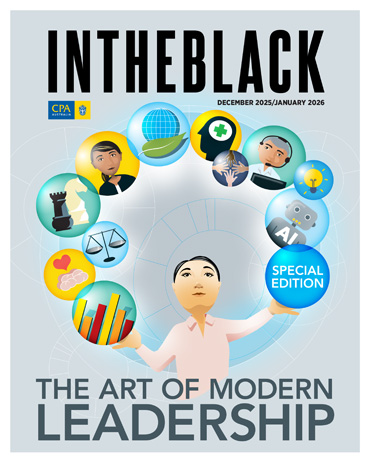Loading component...
At a glance
When Haryane Mustajab FCPA entered the finance industry three decades ago, she did not quite fit “the mould”.
“When I started as a young finance professional, I felt isolated, and that the finance and corporate worlds were not really for women,” says Mustajab, COO and head of finance at Bird & Bird ATMD in Singapore.
“It seemed quite incredible to me that highly successful, professional women should be treated any differently to men.”
Cracks appear in the glass ceiling
Much has changed in finance and accounting since those early days. Cracks have slowly emerged in the “glass ceiling”, and, in recent years, women have started to report different experiences.
Pavani Randeniyage CPA, business banking manager at NAB, joined the bank’s graduate program more than six years ago, and her career has progressed across several roles, including a leadership position.
“I work for an organisation where gender diversity is a focus for our leaders, so I have had a reasonably good experience as a woman in finance,” Randeniyage says.
“In the longer term, my goal is to reach an executive leadership position at a larger organisation. The increasing presence of female CFOs and CEOs in Australia gives me comfort that it is achievable.”
Women on Boards runs a Women in Leadership program with CPA Australia and has been tracking the gender composition of the country’s boards for more than two decades. Company co-founder and executive director Claire Braund has seen significant progress.
“The ASX 200, which was at 7 per cent when we started Women on Boards in 2006, is now tracking routinely around 37 per cent,” Braund says.
In Hong Kong, 24 per cent of CFO positions are filled by women, which is higher than the global average of 15 per cent.
In Singapore, the gender pay gap is also getting smaller. Whereas in 2018 full-time female employees aged 25 to 54 earned 16.3 per cent less than their male counterparts, in 2020 that difference was 14.4 per cent, according to data from the Ministry of Manpower.
Despite this positive change, there is still a long way to go to reach a balance of 40:40:20 in CEO and C-suite roles, says Braund – “that is, 40 per cent men, 40 per cent women and 20 per cent of either or another gender.”
Data from the Workplace Gender Equality Agency (WGEA) shows women make up less than 22 per cent of CEO roles in the finance sector in Australia, and only 37 per cent of key management roles.
The gender pay gap in Australia also remains stubbornly wide, with data from WGEA showing a total remuneration gender pay gap of 21.7 per cent. For every A$1 on average a man makes, women earn A$0.78. Over the course of a year, that difference adds up to A$26,393.
Diversity, Inclusion and Belonging
Beyond window dressing
Carol Kulik, Bradley Distinguished Professor in business at the University of South Australia, says women help create organisations that are better for everyone.
“Organisations with women in leadership roles adopt more employee participation practices,” Kulik says. “They adopt diversity practices, so they become a much more inclusive environment.
“They tend to be creative and innovative, so you end up with products that better serve customers. You also end up producing better services for the community, because women in leadership roles tend to be socially responsible, and they engage in philanthropy.”
If the benefits are clear, what factors continue to hold women back?
Isabel Metz, professor of organisational behaviour at Melbourne Business School, says research into this question began in the 1960s, when discussions centred on “fixing women”.
“The focus was very much on, ‘Oh, we do not have as many women in leadership positions, because they do not have the right education, they do not have the right work experience or maybe they have had too many career breaks’.
“We then moved to an era that lasted until the mid-1990s, which was a focus on advising organisations to change their policies and practices.”
The challenge, Metz adds, was that many organisations were engaging in “window dressing”.
“They had beautiful policies and practices, but they did not spend the resources on explaining to their managers why they had those policies, so that they could get buy-in.”
Towards shared responsibility
More recently, research into women in leadership has centred around self-help books for career advancement.
“Sheryl Sandberg’s Lean In, for example, sold millions of copies,” says Metz. “I found that there were pros and cons to these books.
“To use Lean In as an example, it did rely a lot on empirical evidence and research, which was a good thing. The second thing was that, in explaining how some women become successful by using particular strategies, the book gave women hope and also empowered them and enhanced their confidence.”
However, Metz adds that such books also put much of the responsibility on women to fix the system.
“In doing so, those kinds of books are saying to the managers, the decision makers, the organisations and even legislators and society, ‘You do not have to do anything to change things, because the onus is on the women’. This relieves everybody else from the responsibility of contributing to fix this problem.
“These kinds of books also tend to be quite selective in terms of the examples they give and may not be representative of all women,” Metz says.
The childcare challenge
As women typically have more career breaks than men to care for children, it is widely considered more costly for organisations to replace them, even temporarily.
“This is a very common and popular justification for considering women as riskier appointments and as having less work experience or being less qualified overall,” Metz says.
“However, there is quite a lot of research, including my own research in banking and finance, that shows that this perception is more myth than reality.”
As part of her research into gender diversity, Metz followed a group of women in finance over a seven-year period to find out why they had left their organisations.
“Almost 90 per cent said that they had left because of a combination of reasons,” Metz says. “For instance, flexible policies were not implemented or available to them, but also they felt that they were being pushed out of the organisation.”
Randeniyage is already thinking about the risks of a career break.
“The decision of when my husband and I want to start a family is influenced by a variety of factors, and my career is one of them, given the time I expect to take off work,” she says.
“I have read countless articles and studies that show taking time off to have a baby can impact your earnings, promotion potential and career path, so this is a complex issue that women have to consider.”
Focus on the solutions
Barriers for women in accounting and finance remain complex, but Braund says it is time to focus on the solutions.
These could include ensuring gender-balance targets are in place across organisations and around recruitment processes, Braund says.
“Drill into lazy responses from interview panels and managers responsible for recommending a promotion because, in the end, many organisations have a good pool of women, but it is in a promotion pipeline where you see some of the bias start to occur.
“You hear things like, ‘she just was not a good fit’, ‘she just is not ready’, ‘she is too emotional’, or ‘she just does not have a strategic focus’. Ask for specifics and make people accountable for what they say and for their decisions.”
Braund also recommends highlighting areas of good practice and building a culture of improvement linked to KPIs.
“The data is there. The fact is, we can now publish the gender pay gap,” Braund adds.
“I mean, why would ambitious young women coming into the workforce work for a company with a 30 per cent gender pay gap?”
The value of professional ‘sisterhoods’
Randeniyage says mentorships can provide aspiring female leaders with guidance and experience.
“I’d also suggest networking and building connections with other women in finance who can help with career progression or other opportunities. I have learned that there will always be someone willing to lend a hand and support, but we need to be confident enough to ask for help when we need it.”
Mustajab also believes in the value of mentorships and a professional “sisterhood”.
“It is so important for women in the professional community to be like a sisterhood and to help each other to remove self-doubt,” she says.
“I learned early in my career that it was so important to have a mentor, and I was in the company of strong women, which was absolutely priceless in terms of having examples to look up to.”
For Mustajab, there is “no one-size-fits-all solution” to the issue of gender equity.
“As a finance leader, it is so important to make time for all young professionals. I especially make time to support female colleagues, because I know it can be a tough journey, especially if you are a working mother.
“My advice to young women in finance is to always keep learning, stay curious and, above all, never give up.”
The trickle-down effect
Research from University of South Australia has found that applying regulatory pressure to organisations to close the gender leadership gap and the gender pay gap is not particularly effective. The solution, Professor Carol Kulik says, is found in the “trickle-down effect”.
“What our research shows is that if you have the right flexible practices, women advance into leadership roles, but it happens slowly. What the trickle-down effect shows is that if you increase the number of women in a senior role, you will, in a very short period – just one year – get more women in the organisational level one step down.
The research found that if organisations went from having no women on their board to adding three women the following year, they experienced a 16 per cent increase in female senior management in one year.
“The trickle-down effect operates through two mechanisms,” Kulik explains. “One mechanism is that when you have women in these senior roles, maybe they are doing more advocacy, maybe they are doing more mentoring or maybe they are identifying talent and suggesting women who could be promoted.
“Secondly – and what I love about the trickle-down effect – is it can also happen very passively. It creates an extremely powerful passive signalling effect, because once we have women in those senior roles, they are visible.”
“I sometimes say that the way we are going to address this problem is to think both about the tortoise and the hare,” Kulik adds.
“It is about fast things, but also sustainable things. I think flexibility is going to make organisations much more accommodating of lots of different types of people, including women. It is just not a quick fix.”

